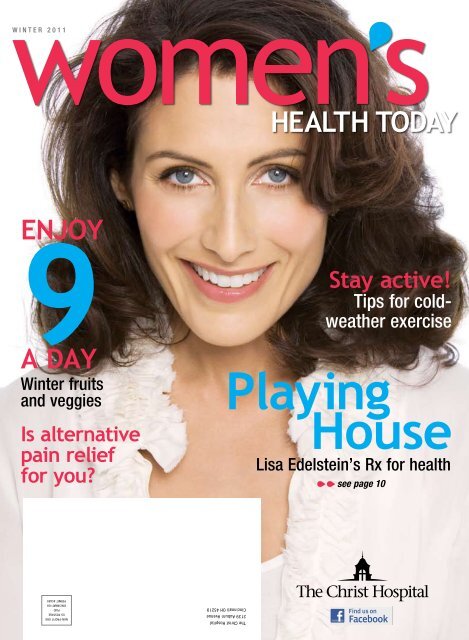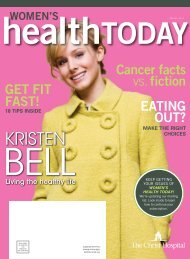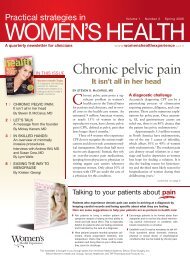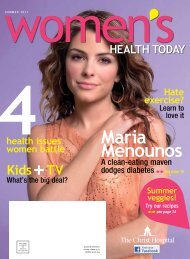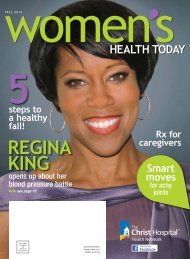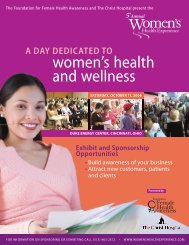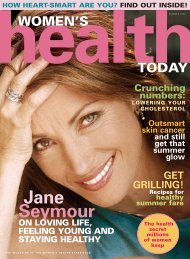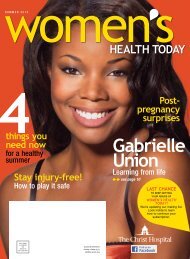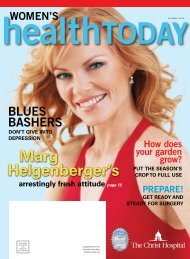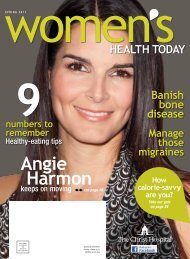Playing House - Women's Health Experience
Playing House - Women's Health Experience
Playing House - Women's Health Experience
Create successful ePaper yourself
Turn your PDF publications into a flip-book with our unique Google optimized e-Paper software.
women s<br />
w i n t E R 2 0 1 1<br />
HealtH today<br />
enjoy<br />
9<br />
a day<br />
winter fruits<br />
and veggies<br />
Is alternative<br />
pain relief<br />
for you?<br />
non-profit org<br />
us postage<br />
paid<br />
cincinnati oh<br />
permit #5489<br />
<strong>Playing</strong><br />
<strong>House</strong><br />
Lisa Edelstein’s Rx for health<br />
the christ hospital<br />
2139 auburn avenue<br />
cincinnati oh 45219<br />
Stay active!<br />
tips for coldweather<br />
exercise<br />
see page 10
Get back to the things you love.<br />
If pelvic pain affects your daily life or has gotten worse<br />
over time, it may be time to see a specialist. The<br />
physicians at The Christ Hospital Women’s Surgery Center<br />
are experts in minimally invasive techniques<br />
to treat the many possible causes of pelvic pain, such<br />
as uterine fibroids, endometriosis, ovarian cysts and<br />
other gynecological problems. Which can mean less<br />
pain. Less scarring. Shorter recovery time — and a<br />
faster return to the things you love.<br />
To find a doctor who specializes in minimally<br />
invasive surgery, call 513.585.1000.<br />
TheChristHospital.com/women | Caring Above All. SM
© istockphoto.com/Kutay Tanir/Alex Slobodkin<br />
in this issue...<br />
9<br />
Stick to those<br />
resolutions!<br />
>> dePartmentS<br />
2 LETTER FROM THE FOUNDER<br />
Welcome winter!<br />
6 HEALTH HEADLINES<br />
What’s making news<br />
in women’s health<br />
9 SEX & GENDER MATTERS<br />
Stick to those resolutions!<br />
14 HEALTHY BITES<br />
Wintry ways to get your<br />
9-a-day<br />
20 HEALTHY MOVES<br />
Cold-weather workouts<br />
24 HEALTH SMARTS<br />
A swollen situation?<br />
W i n t e r 2 0 1 1<br />
>> FeatureS<br />
3 Knee-friendly fitness<br />
4 Sick enough to skip?<br />
5 Say good night to<br />
sleep problems<br />
8 Are you pre-sick?<br />
<strong>Health</strong>y changes can ward<br />
off disease<br />
10 <strong>Playing</strong> <strong>House</strong><br />
Lisa Edelstein’s Rx for health<br />
may surprise some<br />
16 Heathcare at home!<br />
Self-monitoring tips to<br />
keep you in shape<br />
5<br />
Say good night<br />
to sleep<br />
problems<br />
16<br />
Heathcare<br />
at home!<br />
18 Scarred for life?<br />
8 ways to cover up<br />
19 Banish the belly blues<br />
Why excess ab fat is bad news<br />
22 No-pills pain relief<br />
Alternative therapies may help<br />
20<br />
Cold-weather<br />
workouts<br />
www.womenshealthexperience.com<br />
1
LETTER FROM THE FOUNDER<br />
Dr. Karram and his wife,<br />
Mona, are the founders of the<br />
Foundation for Female <strong>Health</strong><br />
Awareness, a nonprofit<br />
organization dedicated to<br />
improving women’s health by<br />
supporting unbiased medical<br />
research and educating women<br />
about their health.<br />
miCKeY m. KArrAm, mD<br />
PRESIDENT AND Co-FouNDER<br />
2 2 women’s health today<br />
Welcome<br />
winter!<br />
FouNDATIoN FoR FEmAlE HEAlTH AwARENESS<br />
>> JuSt BeCAuSe tHe WeAtHer mAY Be<br />
LeSS tHAn AgreeABLe DoeSn’t meAn<br />
You SHouLD ABAnDon Your queSt For<br />
gooD HeALtH AnD FitneSS. Women’s<br />
<strong>Health</strong> Today can help you stay on track in<br />
this new year, in more ways than one. You<br />
can also read this issue in more ways than<br />
one: Visit www.theChristHospital.com/<br />
WHt to view our new digital edition.<br />
ExErCISE MOrE AND<br />
EAT bETTEr<br />
We all know the mantra: To lose weight,<br />
you must move more and eat less. If there’s<br />
snow coming down outside, you may be<br />
more likely to snuggle up on the sofa to watch a favorite TV show and enjoy<br />
a cup of hot chocolate. Instead, take a look at our trio of articles designed to<br />
help you get through the season, starting with “Stick to those resolutions!” on<br />
page 9, and then our article on “Wintry ways to get your 9-a-day” on page 14,<br />
for some ideas about healthier eating with fruits and vegetables. Follow those<br />
articles with “Cold-weather workouts” on page 20, to inspire you to get the<br />
activity you need.<br />
There’s plenty more information you’ll find of interest in this issue, including<br />
some ideas about how “No-pills pain relief” may be an answer for you, on page<br />
22, and how you can make healthy changes now to ward off serious health<br />
issues in the future (“Are you pre-sick?” on page 8).<br />
If there’s a specific healthcare topic you’d like to read about in the pages of<br />
Women’s <strong>Health</strong> Today, please let us know. We’re here to help you and your<br />
loved ones achieve a happier, healthier lifestyle—now and into the future.<br />
Sincerely,<br />
women s<br />
HealtH today<br />
tHe mAgAzine oF<br />
tHe FounDAtion For FemALe HeALtH AWAreneSS<br />
Founders<br />
mickey m. Karram, mD / mona Karram<br />
national advisory Board<br />
LINDA BRUBAkER, MD, Professor of Obstetrics and Gynecology,<br />
Urogynecology Urology, Loyola University Chicago Stritch School<br />
of Medicine; Co-Director, Women’s Pelvic Medicine Center,<br />
Loyola University Medical Center<br />
VIVIEN k. BURT, MD, PhD, Associate Professor of<br />
Clinical Psychiatry, The David Geffen School of Medicine at UCLA;<br />
Founder and Director, Women’s Life Center,<br />
UCLA Neuropsychiatric Institute and Hospital<br />
VIVIAN M. DIckERSON, MD, Associate Clinical Professor of<br />
obstetrics and gynecology, university of California irvine;<br />
Director, Division of general obstetrics and gynecology, uCi<br />
medical Center; Director of uCi’s Post reproductive Women’s<br />
integrative <strong>Health</strong> Center<br />
TOMMASO FALcONE, MD, Professor and Chairman, Department<br />
of gynecology and obstetrics, the Cleveland Clinic Foundation;<br />
Co-Director, Center for Advanced research in Human<br />
reproduction and infertility<br />
SEBASTIAN FARO, MD, PhD, Clinical Professor of obstetrics and<br />
gynecology, Women’s Hospital of texas<br />
nieca GoldBerG, Md, Assistant Professor of medicine,<br />
SunY <strong>Health</strong> Science Center, Brooklyn, new York;<br />
Clinical Assistant Professor of medicine, new York university<br />
THOMAS HERzOG, MD, Professor of Clinical obstetrics and<br />
gynecology, Columbia university College of Physicians and<br />
Surgeons; Director, Division of gynecologic oncology, Columbia<br />
university medical Center, new York<br />
BARBARA LEVY, MD, medical Director, Women’s <strong>Health</strong> & Breast<br />
Center, St. Francis Hospital, Federal Way, Washington; Assistant<br />
Clinical Professor of obstetrics & gynecology, Yale university<br />
School of medicine; Assistant Clinical Professor of obstetrics and<br />
gynecology, university of Washington School of medicine<br />
Wendy l. WriGht, arnP, FaanP, Adult/Family nurse<br />
Practitioner; Adjunct Faculty, Fay W. Whitney School of nursing,<br />
university of Wyoming<br />
the christ hosPital staFF<br />
President and ceo Susan Croushore<br />
chief Business development officer victor DiPilla<br />
chief hospital officer Deborah Hayes<br />
chief strategy and Mission officer Heather Adkins<br />
chief Medical officer Berc gawne, mD<br />
editor Arin Kraemer<br />
custoMer service<br />
For more information about services at<br />
the Christ Hospital, please contact Arin Kraemer at<br />
arin.kraemer@thechristhospital.com or 513-585-3945.<br />
For a free subscription to Women’s <strong>Health</strong> Today, call<br />
513-585-1000 or visit www.thechristhospital.com/Wht.<br />
Women’s <strong>Health</strong> Today is published four times a year by<br />
the Christ Hospital, 2139 Auburn Avenue, Cincinnati, oH 45219,<br />
in conjunction with the Foundation for Female <strong>Health</strong> Awareness,<br />
Po Box 43028, Cincinnati, oH 45243. this is volume 7, issue 1.<br />
© 2010 by the Christ Hospital and the Foundation for<br />
Female <strong>Health</strong> Awareness. All rights reserved.<br />
the information contained herein is not a<br />
substitute for professional medical care<br />
or advice. if you have medical concerns, seek the<br />
recycle-logo_2options_v2.ai<br />
guidance of a healthcare professional.<br />
Women’s <strong>Health</strong> Today magazine is part of<br />
Women’s <strong>Health</strong> experience, the flagship program of the<br />
Foundation for Female <strong>Health</strong> Awareness. Women’s <strong>Health</strong><br />
experience is a unique initiative aimed at connecting women<br />
with healthcare experts, as well as their local hospitals, to learn<br />
about important issues that may affect their health. through<br />
Women’s <strong>Health</strong> experience, Women’s <strong>Health</strong> Today magazine<br />
and www.womenshealthexperience.com, Printed With Soy Ink Printed With Soy Ink you’ll get objective,<br />
timely information. You can also sign up for free e-newsletters<br />
containing health news and results of medical studies.<br />
Please Recycle This Publication<br />
Sign up now at www.womenshealthexperience.com.<br />
Cover: LiSA eDeLStein<br />
© 2010 JuLie Please DenniS Recycle BrotHerS/CorBiS This Publication outLine<br />
Printed With Soy Ink<br />
Please Recycle This Publication<br />
Printed With Soy Ink<br />
Please Recycle This Publication
© istockphoto.com/lucas Cornwell<br />
Knee-friendly<br />
fitness >> By tim Enwright, Pt<br />
>> WHen it ComeS to tHe Knee,<br />
Women AnD men Are not CreAteD<br />
equAL. Wider hips and weaker<br />
thigh muscles put the female joint<br />
under special strain, making women<br />
more likely than men to suffer knee<br />
osteoarthritis and be more injury<br />
prone. But these exercises can help<br />
your knees withstand wear and tear.<br />
STrENGTH bUILDErS<br />
>> Isometric quadriceps builder<br />
Sit on the floor with legs extended<br />
in front of you. Place a rolled-<br />
up towel under your knees, then<br />
tighten your quadriceps. Hold for<br />
ten seconds, release and repeat. Do<br />
five repetitions.<br />
>> Short arc quads builder<br />
Lie on your back with legs extended<br />
and a rolled-up towel placed under<br />
one knee. Lift your foot until the<br />
leg is straight. Hold for three seconds,<br />
then slowly lower to the floor. Do<br />
one set of ten repetitions per leg.<br />
>> Inner-thigh conditioner<br />
Lie on your back with knees bent<br />
and feet on the floor. Place a pillow<br />
Protect your knees<br />
between your knees and squeeze to<br />
hold pillow in place. Hold for ten<br />
seconds; repeat five times.<br />
>> Quadriceps extension<br />
Sit on the edge of a chair. Keeping<br />
your back straight, straighten<br />
your knee. Pause for a count of<br />
three. Slowly lower. Do ten repeti-<br />
tions on each leg.<br />
FLExIbILITy PrOMOTErS<br />
>> Quadriceps stretch<br />
Stand up and bend one leg behind<br />
you. Keeping your hips even, grab<br />
the ankle of the bent leg and pull the<br />
foot toward your buttocks. Hold for<br />
30 seconds; return leg to the floor<br />
and switch legs. (If necessary, use<br />
your free hand to lean against a wall<br />
for support.) Do three repetitions.<br />
>> Hamstring stretch<br />
Sit on a bed or couch with one<br />
leg extended and the other knee<br />
bent with your foot on the floor.<br />
Keeping your back straight, lean<br />
toward your toes. Hold for<br />
30 seconds; repeat on the other<br />
leg. Do three repetitions. wHt<br />
• Avoid high heels. They force thigh muscles to work harder, putting<br />
added pressure on the knee and leading to osteoarthritis.<br />
• Walk, swim and cycle to build knees.<br />
• Don’t close doors, drawers or cabinets with your knees.<br />
• Lose excess pounds. They put added strain on your knees.<br />
don’t bend<br />
down to pain!<br />
To schedule an appointment<br />
with a physical therapist at any<br />
of our Christ Hospital Physical<br />
Therapy Center locations, call<br />
513-585-3838.<br />
>> Tim Enwright, PT, is clinical manager of The Christ Hospital Physical and Occupational<br />
Therapy Centers in Kenwood and Mason.<br />
www.womenshealthexperience.com<br />
3
Sick enough<br />
to skip?<br />
>> A LittLe SniFFLe. A SLigHt CougH. SHouLD You<br />
StAY Home From WorK? Should your kids skip school?<br />
Here are some guidelines to help you decide what to<br />
do when you or a family member is sick:<br />
>> Fever. Fever is a common symptom of viral infections,<br />
like influenza. If temperatures are 100.4° F or higher, it’s<br />
important to stay home and drink plenty of liquids. You or<br />
your loved one should be fever-free for 24 hours (without<br />
medicine) before returning to work or school.<br />
>> Cough or runny nose. If there’s no fever or other<br />
symptoms along with the cold, attending school or going<br />
to work is fine. Bad coughs require a stay at home and pos-<br />
sibly a trip to the family physician. You could have a severe<br />
cold or possibly the flu, bronchitis or pneumonia. But<br />
when the cough improves, then it’s back to work or school.<br />
There’s no need to wait for the cough to disappear entirely.<br />
4 women’s health today<br />
By Jennifer white, MD<br />
Get vaccinated!<br />
The most important ways to prevent the spread of<br />
viruses and bacteria are to wash your hands often<br />
and get a yearly flu vaccine. If you’re experiencing<br />
flu-like symptoms or would like to schedule a<br />
flu vaccination, call 513-585-1000 or visit<br />
www.ThechristHospital.com/TcHMA/ for an<br />
appointment with a Christ Hospital primary care<br />
physician.<br />
>> Diarrhea or vomiting. Stay home until the illness is<br />
over, and for 24 hours after the last episode (without<br />
medicine). Though diarrhea and vomiting aren’t<br />
usually associated with the seasonal flu, they sometimes<br />
occur with H1N1.<br />
>> Sore throat. A minor sore throat usually isn’t a<br />
problem, but severe pain could be a sign of strep<br />
throat, even without fever. Other symptoms of strep<br />
are headache and upset stomach. Stay home and call<br />
your family physician, who can administer a test to<br />
determine if it’s strep. Return to school or work<br />
24 hours after beginning antibiotic treatment.<br />
>> Earaches. Middle ear infections are usually preceded<br />
by upper respiratory infections. Younger children with<br />
a suspected ear infection, especially those who have a<br />
fever and appear sick, should be evaluated by a physi-<br />
cian. Earaches are generally not contagious, so there’s<br />
no need to stay home.<br />
>> Pinkeye. Pinkeye (conjunctivitis) is highly<br />
contagious. Most cases are caused by a virus, which<br />
won’t respond to antibiotics. Bacterial conjunctivitis<br />
will require an antibiotic; your physician will be<br />
able to determine if this is the case. Stay at home<br />
until a physician has given the OK to return.<br />
>> Rash. A skin rash requires a physician visit, as it<br />
could be a symptom of an infectious disease. One<br />
possibility is impetigo, a bacterial skin infection that’s<br />
very contagious and requires antibiotic treatment. wHt<br />
>> Jennifer White, MD, is a board-certified family medicine physician with<br />
The Christ Hospital Medical Associates in Madeira.<br />
© istockphoto.com/Renee Keith
Say good night to<br />
sleep problems >> By Jennifer Spata, MD<br />
>> WHen WAS tHe LASt time You FeLt WeLL reSteD? Not getting enough<br />
sleep can lead to weight gain, impair memory and raise your risk of developing<br />
high blood pressure, diabetes and depression, not to mention make driving a<br />
dangerous proposition. Try these tips to conquer common sleep issues:<br />
>> SlEEP StEalER: An overactive<br />
mind, stressing over money, your<br />
to-do list or worries about your job<br />
the remedy:<br />
• Relax. Read, listen to soothing<br />
music or knit until you feel sleepy.<br />
• Make a to-do list before bedtime.<br />
Tell yourself you’ll deal with it<br />
tomorrow, then go to sleep worry<br />
free.<br />
• Avoid staying in bed, looking at<br />
the clock and willing yourself to<br />
sleep. If after 30 minutes you’re<br />
not sleepy, get up and read,<br />
stretch or deep breathe. Then try<br />
to go to sleep again.<br />
• Speak with a healthcare profes-<br />
sional if you’re depressed or<br />
overwhelmed by stress.<br />
Sleep soundly!<br />
>> SlEEP StEalER: Bad habits, like<br />
staying up late, having a late-night<br />
cocktail, falling asleep with the TV<br />
on or working in bed<br />
the remedy:<br />
• Go to bed and get up at the same<br />
time every day—weekends, too.<br />
• Skip caffeine, nicotine and alcohol<br />
in the evening. Alcohol causes<br />
less restful sleep and caffeine and<br />
nicotine are stimulants.<br />
• Keep your bedroom cool, dark<br />
and quiet.<br />
• Avoid watching TV or working<br />
for an hour before bedtime and<br />
don’t do either in your bedroom.<br />
>> SlEEP StEalER: Sleep disorders,<br />
including obstructive sleep apnea,<br />
If you’ve been sleeping poorly for a month or more and<br />
drowsiness prevents you from carrying out your daily routine<br />
or you’re unusually tired during the day, call 513-585-1000<br />
or visit www.ThechristHospital.com/TcHMA/ to schedule<br />
an appointment with a Christ Hospital primary care physician.<br />
>> Jennifer Spata, MD, is a board-certified family medicine physician with<br />
The Christ Hospital Medical Associates in Mt. Auburn.<br />
chronic insomnia, restless legs<br />
syndrome and leg cramps<br />
the remedy:<br />
Speak with your healthcare provider,<br />
who may order a sleep study<br />
to determine what’s causing the<br />
problem and how to treat it.<br />
>> SlEEP StEalER: Pregnancy<br />
symptoms, like constantly getting<br />
up to go to the bathroom in the<br />
middle of the night, your growing<br />
belly (which makes it difficult to<br />
get comfortable) and acid reflux<br />
the remedy:<br />
• Cut back on caffeinated<br />
beverages.<br />
• Sleep on your side with your<br />
knees bent to take pressure off<br />
your back.<br />
• Place pillows between your knees<br />
to help support you as you sleep.<br />
• Avoid eating spicy foods or large<br />
meals before bedtime to prevent<br />
heartburn. wHt<br />
www.womenshealthexperience.com<br />
5
<strong>Health</strong> Headlines<br />
>> what’s making news in women’s health<br />
another reason to<br />
be agreeable<br />
Bad news for those antagonistic<br />
people out there—especially those<br />
with a competitive or aggressive<br />
edge. You’re not doing your heart<br />
any favors, say researchers at the<br />
U.S. National Institute on Aging.<br />
They found that such personalities<br />
have greater amounts of thickening<br />
of the neck, or carotid, arteries<br />
compared to those who were<br />
more agreeable. Some of these<br />
people were also more likely to have<br />
advanced arterial thickening down<br />
the road, increasing their risk for a<br />
heart attack and stroke. To gather<br />
their findings, researchers gave<br />
5,614 Italians in four villages standard<br />
personality tests. Those who<br />
scored lowest in “agreeableness”<br />
had a 40 percent increased risk for<br />
artery thickening—similar to having<br />
the cardiovascular risk factor known<br />
as metabolic syndrome. The findings<br />
may help physicians guide appropriate<br />
patients to interventions such as<br />
anger management.<br />
6 women’s health today<br />
Choose<br />
H2O at<br />
home<br />
Is the secret to successful<br />
weight loss your own tap water?<br />
Drinking water could be that<br />
important to weight-loss efforts,<br />
says research presented to the<br />
American Chemical Society.<br />
Researchers found that drinking<br />
just two 8-ounce glasses of this<br />
zero-calorie beverage before<br />
each meal could help you lose<br />
as much as 40 percent more<br />
weight. In the study, 48 people<br />
ages 55 to 75 were divided<br />
into two groups. Both groups<br />
followed low-calorie diets, but<br />
one group drank two cups of<br />
water before each meal. After<br />
12 weeks, the water drinkers<br />
lost about 15.5 pounds, compared<br />
to 11 pounds for the<br />
others. An interesting note—<br />
prior research demonstrates<br />
that these benefits may only<br />
help older adults. Since your<br />
stomach takes longer to empty<br />
as you age, it’s likely that drinking<br />
water right before each meal<br />
and being middle-aged or older<br />
will lead you to a greater feeling<br />
of fullness and therefore translate<br />
to eating fewer calories. No<br />
matter your age, it’s smart to<br />
choose water over high-calorie,<br />
sugar-laden beverages. So,<br />
reach for a glass of water the<br />
next time you’re thirsty.
Images on pages 6 and 7 © istockphoto.com/okea/SammyC/Transfuchsian/Stockphoto4u<br />
Even<br />
lowest<br />
levels of<br />
smoke<br />
harmful to<br />
health<br />
“I only smoke when I have<br />
a drink,” or “I only light up<br />
when life gets too stressful.”<br />
Sound familiar? If you<br />
think infrequent smoking<br />
isn’t harmful, think again.<br />
According to a small study<br />
out of New York-Presbyterian<br />
Hospital/Weill Cornell Medical<br />
Center, occasional smoking<br />
or secondhand exposure—<br />
even at low levels—can put<br />
you at risk for diseases such<br />
as lung cancer down the<br />
road. Researchers found that<br />
among the 121 participants,<br />
even at the lowest detectable<br />
exposure levels, smoke<br />
had direct effects on how<br />
genes functioned in cells that<br />
lined airways. All levels of<br />
nicotine or cotinine—which<br />
are both in the body when<br />
you smoke—cause genetic<br />
abnormalities. So avoid even<br />
taking a puff or spending<br />
a few minutes in a smoky<br />
room.<br />
Occasional smoking or secondhand<br />
exposure can put you at<br />
risk for diseases such as lung<br />
cancer down the road.<br />
do you know your<br />
breast cancer risk?<br />
Want to learn about your risk for the<br />
disease? a computer program called the<br />
Breast cancer risk assessment tool—<br />
developed in part by the national cancer<br />
institute—helps healthcare professionals<br />
estimate your risk of breast cancer by<br />
accounting for certain risk factors:<br />
• breast abnormalities, such as ductal<br />
carcinoma in situ (dcis) and lobular carcinoma<br />
in situ (Lcis), which increase the risk<br />
for developing invasive breast cancer<br />
• being older than age 50<br />
• having your first menstrual period<br />
before age 12<br />
• being older when you had your first<br />
child; most women who have their first<br />
child after age 30 have a greater risk of<br />
developing breast cancer than women who<br />
have children younger<br />
• breast cancer in a sister, mother or<br />
daughter<br />
• having needed breast biopsies, especially<br />
if the biopsies showed a change in<br />
breast tissue known as atypical hyperplasia;<br />
the biopsies themselves do not increase risk<br />
• being a Caucasian woman; however,<br />
african-american women—though at lower<br />
risk than caucasian women—are more<br />
likely to die of the disease<br />
Learn more about the Breast cancer<br />
risk assessment tool at www.cancer.gov/<br />
bcrisktool/, and remember to discuss your<br />
risks and concerns with your physician.<br />
www.womenshealthexperience.com
Are you<br />
pre-sick?<br />
<strong>Health</strong>y changes<br />
can ward off disease<br />
>> iF Your BoDY WArneD You<br />
tHAt You Were going to get<br />
SiCK BeFore it HAPPeneD, You’D<br />
ProBABLY Do everYtHing in<br />
Your PoWer to Prevent it From<br />
HAPPening, rigHt? With some dis-<br />
eases, you do get an advance warning.<br />
Don’t delay in taking action to<br />
prevent these common conditions:<br />
8 women’s health today<br />
>> Pre-diabetes means your<br />
blood sugar levels are higher<br />
than normal, but not high<br />
enough to be classified as type 2<br />
diabetes.<br />
Warning signs: Pre-diabetes<br />
often has no symptoms, but<br />
you can look out for signs<br />
of type 2 diabetes, such as<br />
extreme hunger, increased<br />
thirst, unexplained weight loss,<br />
frequent urination, fatigue,<br />
blurred vision, slow-healing<br />
sores and frequent infections.<br />
testing: Your healthcare provider<br />
may perform an A1C<br />
test, which measures average<br />
blood sugar levels for the past<br />
few months, or other screening<br />
tests. If your levels are<br />
normal, your provider may<br />
perform a screening test every<br />
three years. If they’re high,<br />
you likely have pre-diabetes.<br />
treat it now: Eating healthy<br />
foods, exercising regularly and<br />
maintaining a healthy weight<br />
may help lower your blood<br />
sugar, helping you avoid diabetes.<br />
If you do have diabetes,<br />
learn self-monitoring tips on<br />
page 16 of this issue.<br />
>> Pre-osteoPorosis, also<br />
called osteopenia or low bone<br />
density, isn’t a disease but<br />
rather a marker for fracture<br />
risks.<br />
Warning signs: Many people<br />
don’t know they have bone<br />
loss until they break a bone or<br />
their bones become so weak<br />
that a sudden strain, bump or<br />
fall causes a hip fracture or<br />
collapsed vertebra.<br />
testing: Bone mineral density<br />
tests can detect low bone<br />
density.<br />
treat it now: Lifestyle changes<br />
can help slow the progression<br />
of bone loss and reduce<br />
fracture risks. Eat foods high<br />
in calcium and vitamin D,<br />
exercise to build muscle and<br />
maintain joint health and<br />
don’t smoke. Your healthcare<br />
provider may recommend<br />
medications to slow bone loss<br />
and increase bone density. wHt<br />
Get and stay<br />
healthy!<br />
learn more about disease<br />
prevention and maintaining<br />
a healthy lifestyle at www.<br />
Get<strong>Health</strong>ycincinnati.com.<br />
Image on page 7 © Thinkstock; Image on page 8 © istockphoto.com/Kutay Tanir
Sex & Gender matters<br />
The latest findings on women-specific health<br />
from the Society for Women’s <strong>Health</strong> Research<br />
>> By Jennifer wider, MD<br />
Stick to those resolutions!<br />
>> WitH tHe neW YeAr Come voWS to ADoPt A<br />
HeALtHier LiFeStYLe. For many women, taking on new<br />
habits and maintaining healthy behaviors may be dif-<br />
ficult, especially during the holidays and into the new<br />
year. During this season of stress, adding promises to<br />
change old, unhealthy habits and create new behaviors<br />
may be difficult to uphold.<br />
“Sometimes we take on too many changes and cre-<br />
ate too many goals at one time,” explains Erica Wright,<br />
a licensed clinical social worker and psychotherapist<br />
who practices in New York City and Fairfield, Conn.<br />
“Instead of being able to maintain these new habits, we<br />
fail because we become overwhelmed.”<br />
But keeping health-related resolutions can make a<br />
big difference when it comes to long-term health. For<br />
women who are overweight or obese, shedding those<br />
extra pounds can be lifesaving. Obesity has been linked<br />
to an increased risk of heart disease, breast cancer and<br />
type 2 diabetes. Studies have shown that losing weight<br />
through diet and exercise can lower the risk of these<br />
and other diseases.<br />
Many women start off strong in January with new<br />
health club memberships but quickly get frustrated<br />
if they don’t achieve their desired weight loss. Many<br />
complain that they’re unable to keep their resolutions,<br />
no matter how hard they try. “We fall into the rhythm<br />
of life and into our old patterns,” says Wright.<br />
SO WHAT CAN yOU DO?<br />
Wright suggests streamlining your resolutions:<br />
“Pick one change versus taking on many. For example,<br />
quitting smoking is a massive life change that brings so<br />
many health benefits, but choosing to lose weight on<br />
top of that is too much to handle all at once.”<br />
Enacting small and reasonable changes may make<br />
them easier to incorporate into your already busy life-<br />
style. Focus on one change at a time. For example, if<br />
you want to exercise more, try to work that into your<br />
routine before taking on any more challenges. Even if<br />
you walk briskly to work, take the stairs or get to the<br />
gym once a week, it can make a difference.<br />
“Incorporate other goals throughout the year,”<br />
says Wright. “You don’t have to start everything on<br />
January 1.” wHt<br />
learn more!<br />
The Society for women’s <strong>Health</strong> Research (SwHR), a<br />
national nonprofit organization based in washington, D.C.,<br />
is widely recognized as the thought leader in research on<br />
sex differences and is dedicated to improving women’s<br />
health through advocacy, education and research. To find<br />
this article and more, visit www.swhr.org.<br />
>> Jennifer Wider, MD, is a medical advisor for the Society for Women’s <strong>Health</strong> research in Washington, D.C.<br />
www.womenshealthexperience.com<br />
9
10 women’s health today<br />
© Antoine Verglas/Corbis Outline
Lisa<br />
edelstein’s<br />
Rx for health<br />
may surprise<br />
some<br />
By Bonnie Siegler<br />
>> PLAYing LiSA CuDDY, mD, DeAn oF<br />
meDiCine on Fox’S Hit HoSPitAL DrAmA<br />
“HouSe,” iSn’t SuCH A FAr-FetCHeD<br />
notion For ACtreSS LiSA eDeLStein,<br />
noW going into Her SeventH SeASon<br />
on tHe SHoW. The 44-year-old TV<br />
doc is comfortable in her faux-medical<br />
surroundings, having grown up with<br />
her pediatrician father in New Jersey.<br />
“I’ve been around medicine my whole<br />
life,” explains Edelstein of the parallels<br />
between her TV image and her real life.<br />
“I’ve always loved medicine. In fact, I<br />
observed orthopedic hip surgery earlier<br />
this year in New York City just for fun<br />
and stood right next to the surgeon.”<br />
ContinueD on PAge 12 >><br />
www.womenshealthexperience.com 11
ContinueD From PAge 11<br />
<strong>Playing</strong> take-charge Dr. Cuddy, Edelstein says she<br />
could probably hold her own in an off-camera health<br />
situation. What would she do if someone were in a car<br />
accident? “You’d have to ask first responders what the<br />
injury was—did the person break a leg, break an arm, are<br />
they bleeding?” she says, ticking off a litany of profes-<br />
sional questions. “You have to know what the problem is<br />
to assess it correctly. If somebody were horribly injured,<br />
I’d be right in there. Only, if I knew what I was doing,<br />
that would be much better. At a major accident scene, I<br />
could help by keeping a person company while waiting<br />
for paramedics, which is extremely important.” Joking,<br />
she adds, “I can say ‘clear’ really well, though.”<br />
DIET + ExErCISE = SELF-CONFIDENCE<br />
While Edelstein won’t be dispensing medication or<br />
performing actual surgery anytime soon, the actress is<br />
more than knowledgeable about her own health and<br />
well-being. While being raised in a kosher household,<br />
she became a vegetarian at fifteen. “I made this change<br />
as a kid, not as a grown-up, so it feels like I’ve been<br />
a vegetarian my whole life,” Edelstein says. “For one<br />
thing, it suits me in terms of what I do and don’t like.<br />
I never liked meat, but that’s what we ate every day. I<br />
was a vegetarian waiting to be old enough to make my<br />
own choices and cook my own food.” While attributing<br />
her fit figure to her eating habits, she can’t pin down<br />
vegetarianism as the factor responsible for her bound-<br />
less energy, shiny hair and smooth complexion. “I<br />
wouldn’t know the difference because I’ve been eating<br />
this way for so long,” says Edelstein. “But vegetarian-<br />
ism makes me feel better about how I live my own life,<br />
according to what’s important to me.”<br />
A regular exercise program combined with healthy<br />
eating adds up to a sense of general well-being and<br />
self-confidence for Edelstein. That self-confidence<br />
was on full display during some recently aired risqué<br />
shower and bedroom romps between Dr. Cuddy and<br />
Dr. <strong>House</strong>, revealing more of Edelstein than ever<br />
before. It takes some serious exercise to be in that kind<br />
of shape. “Besides swimming and taking long walks<br />
with my dogs, I practice Ashtanga yoga every day,” she<br />
adds. “I’ve been doing yoga for about 14 years. I like<br />
it because it’s a self-practice and the teacher only gives<br />
you another pose when you’re ready for it. It’s a nice<br />
way to check in with yourself on a daily basis. It helps<br />
center me and keeps me grounded.”<br />
12 women’s health today<br />
the cast of “<strong>House</strong>” includes (l-r) Peter Jacobson, Omar Epps,<br />
Olivia wilde, Hugh Laurie, Lisa Edelstein and Jesse Spencer.<br />
LIFE AWAy FrOM L.A.<br />
A former New Jersey cheerleader for Donald<br />
Trump’s New Jersey Generals and a dancer at several<br />
New York City venues, Edelstein says those activities<br />
are in her very distant past. “I haven’t been dancing in a<br />
long time. My life is too busy for that and I’m not into<br />
that lifestyle anymore. It’s no longer important to me.”<br />
What is significant in her life is traveling and<br />
exploring new cultures. “I love traveling,” she says<br />
enthusiastically. “Within the last five years, I’ve been<br />
to Japan, India, Thailand, South America, Mexico and<br />
all over Europe. And each place is incredible. Traveling<br />
takes me out of my comfort zone and helps put things<br />
in perspective for me, which is really important, espe-<br />
cially for someone in this industry.” Edelstein says her<br />
thespian lifestyle and living in Los Angeles can become<br />
very isolating, so “It’s important for me to step outside<br />
the box whenever I can. It helps rejuvenate and relax<br />
me at the same time,” she adds. On this particularly<br />
hectic day, relaxation seems far away. Both Shazam<br />
and Kapow, the dogs that share her Hollywood Hills<br />
home, are excited about workers putting up solar pan-<br />
els. “They’re completely freaking out,” she says, “but<br />
there’s a lot going on here today.”<br />
Can the same be said for her long-range plans? Has<br />
she set specific goals for future accomplishments? “Oh<br />
no,” Edelstein replies. “There are a lot of things I’m in<br />
the process of doing but I don’t give myself end dates<br />
and I’ve never made a New Year’s resolution in my life.<br />
I’m just a work in progress.” wHt Caulfield<br />
michael / Images Getty ©
Your update in<br />
Women’s <strong>Health</strong><br />
Join Dr. Karram and his guests from The Christ Hospital for an in-depth<br />
radio program exploring a variety of topics essential to your health.<br />
Hosted by<br />
mickey Karram, mD<br />
President and Co-founder,<br />
Foundation for Female<br />
<strong>Health</strong> Awareness;<br />
Director of Urogynecology,<br />
The Christ Hospital,<br />
Cincinnati<br />
Alternate Sundays<br />
8:30–9 a.m.<br />
on 101.9 Fm<br />
Check out upcoming topics and recent programs,<br />
available now at www.womenshealthexperience.com.<br />
aging well<br />
A healthy approach for you and your<br />
aging parents<br />
>> Guests: robert Keyes, mD, Geriatric<br />
medicine Physician, The Christ Hospital<br />
Center for <strong>Health</strong> and Aging<br />
Jason graff, mD, Geriatric medicine<br />
Physician, The Christ Hospital Center for<br />
<strong>Health</strong> and Aging<br />
Get heart-healthy<br />
A wake-up call for women of all ages<br />
>> Guest: James Kong, mD, Cardiologist,<br />
The Christ Hospital<br />
Helping women cope<br />
Learn the facts about alcohol and<br />
drug addiction<br />
>> Guests: Hanish Sethi, mD, Psychiatric<br />
Director, The Christ Hospital Behavioral<br />
<strong>Health</strong>, wellness and Recovery Center<br />
Sumera Khan, mD, Psychiatric Associate<br />
Director, The Christ Hospital Behavioral<br />
<strong>Health</strong>, wellness and Recovery Center<br />
living with chronic pain<br />
resources to help you cope<br />
>> Guest: vivek iyer, mD,<br />
Anesthesiologist, The Christ Hospital<br />
SPONSORED BY IN CONJUNCTION WITH<br />
PreSented By<br />
managing medications<br />
A spoonful of caution: tips on<br />
handling, taking, storing and<br />
securing medications<br />
>> Guests: Stephanie B. Fenwick,<br />
PharmD, Clinical Pharmacy Specialist,<br />
The Christ Hospital<br />
Charles Scharfenberger, PharmD,<br />
Pharmacist, The Christ Hospital<br />
update on breast cancer<br />
concerns<br />
Learn about new treatments for<br />
breast cancer<br />
>> Guests: Jennifer manders, mD,<br />
Director of oncoplastic Surgery,<br />
The Christ Hospital<br />
Ann Weichert, mD, Radiation oncologist<br />
and medical oncologist,<br />
The Christ Hospital<br />
uterine fibroid treatment<br />
A minimally invasive approach<br />
>> Guest: Daniel Long, mD, medical<br />
Director of Interventional Radiology,<br />
The Christ Hospital<br />
www.womenshealthexperience.com<br />
TM<br />
13
HEALTHY BITES<br />
Wintry ways to get<br />
your 9-a-day<br />
>> Are You getting enougH<br />
FruitS AnD veggieS? Most adults<br />
need to eat seven to 13 (aim for<br />
nine) servings of fruits and vegeta-<br />
bles daily, according to the Produce<br />
for Better <strong>Health</strong> Foundation. You<br />
may find it hard to meet those<br />
requirements during the winter<br />
when your produce options may<br />
not excite you as much as they do<br />
in the summer. Fortunately, with<br />
a bit of creativity, there are plenty<br />
of tasty ways to get a variety of<br />
delicious fruits and veggies all<br />
year round, and you can even do it<br />
without busting your budget:<br />
>> think beyond the produce aisle.<br />
Any form of fruits and vegetables<br />
Making canned<br />
soup? Dump a<br />
can of mixed<br />
vegetables into the<br />
pot, too—they’ll<br />
blend right in.<br />
14 women’s health today<br />
counts as a serving: Try canned<br />
pineapple or beets; frozen peas<br />
or blueberries; dried apricots or<br />
roasted soybeans; or peach nectar<br />
or carrot juice. (Just beware that<br />
some canned and frozen fruits have<br />
added sugars such as high fructose<br />
corn syrup.) Try our recipe here<br />
for a quick and easy peach brulée<br />
using canned peaches.<br />
>> Make it easy to munch. Purchase<br />
pre-made fruit salads or carrot and<br />
celery stick platters to nibble on<br />
whenever you’re craving a snack. Or<br />
to save money, cut everything up<br />
yourself, ensuring that healthy fin-<br />
ger foods are always within reach.<br />
>> Create veggie-heavy dishes.<br />
Reduce the amount of meat in<br />
your favorite casserole recipe while<br />
doubling its vegetables. The dish<br />
will have the same delicious, recog-<br />
nizable flavor from the spices and<br />
sauce, but there will be much more<br />
fiber, vitamins and antioxidants and<br />
less fat.<br />
>> Stir up a double-can dinner.<br />
Making canned soup? Dump a can<br />
of mixed vegetables into the pot,<br />
too—they’ll blend right in and<br />
increase your produce intake.<br />
>> Introduce produce to veggie-free<br />
dishes. Spruce up basic macaroni<br />
and cheese with sautéed spinach or<br />
add some eggplant to your ziti.<br />
>> add fruit to dessert dishes. Mix<br />
raisins into your cherry pie recipe.<br />
Serve fresh or dried fruit with<br />
chocolate fondue. wHt<br />
Image on page 14 © Thinkstock; Images on pages 14 and 15 © istockphoto.com/Stephen St-maurice/Roel Smart
Quick peach brulée<br />
> 6 very ripe peaches, halved, or 1 can (1-pound, 13-ounces)<br />
of peach halves, well-drained<br />
> 2 cups vanilla yogurt, at room temperature<br />
> 1 tablespoon granulated sugar<br />
> ½ teaspoon grated orange or lemon peel<br />
> ¾ cup light brown sugar, firmly packed<br />
> Arrange peach halves in a 9-inch glass pie plate. Blend vanilla yogurt,<br />
granulated sugar and orange or lemon peel. Spread over fruit. Just before<br />
serving, sprinkle brown sugar evenly over vanilla yogurt layer, covering the<br />
entire surface. Broil 3 inches from oven flame, one to three minutes or until sugar<br />
melts. Serve immediately, or surface will become very liquid. makes 6 to 8 servings.<br />
How big is a serving?<br />
The following are adult servings of common<br />
fruits and vegetables (portions for children are<br />
typically one tablespoon for each year of age):<br />
> Raw, canned or cooked vegetable or fruit ½ cup<br />
> Raw, leafy vegetable 1 cup<br />
> Potato 1 medium<br />
> Apple, banana, orange, pear 1 medium<br />
> Grapefruit ½ cup<br />
> Raisins, dried fruit ¼ cup<br />
www.womenshealthexperience.com<br />
15
At-home<br />
monitoring allows<br />
you and your<br />
healthcare provider<br />
to remain informed<br />
about your current<br />
health status.<br />
<strong>Health</strong>care at home!<br />
Self-monitoring tips to keep you in shape<br />
>> tAKing An ACtive roLe in Your HeALtHCAre CAn<br />
HeLP You ACHieve Your oPtimum LeveL oF HeALtH. And<br />
at-home monitoring allows you and your healthcare pro-<br />
vider to remain informed about your current health status.<br />
Consider these physician-approved do-it-yourself tests:<br />
16 women’s health today<br />
MEASUrE yOUr bLOOD PrESSUrE<br />
Measuring your blood pressure at home<br />
can show you and your healthcare provider<br />
how much (or how little) your pressure varies during<br />
the day and can provide early detection if you’re in the<br />
beginning stages of high blood pressure. Your provider<br />
uses the measurements to determine whether medicine<br />
is needed or how your current medication is working.<br />
You can pick up a blood pressure monitor without a<br />
prescription at your drugstore.<br />
Blood pressure lower than 120/80 mm Hg<br />
(millimeters of mercury) is considered normal. High<br />
blood pressure is 140/90 mm Hg or higher and pre-<br />
hypertension is anything in between. Most healthcare<br />
providers suggest that you check your blood pressure<br />
several times a day before they determine whether or<br />
not you have high blood pressure.<br />
✆ Call the physician if: your blood pressure continually<br />
reads 140/90 mm Hg or higher or if you feel dizzy<br />
or have chest pain, confusion, ear noise or buzzing,<br />
an irregular heartbeat, a nosebleed, tiredness or vision<br />
changes. If your blood pressure spikes suddenly, you<br />
could be at risk of a stroke, and if your numbers reach<br />
180 mm Hg or higher over 120 mm Hg or higher,<br />
your blood vessels can become damaged and your heart<br />
won’t be able to pump blood properly. If you experi-<br />
ence a severe headache, anxiety or shortness of breath,<br />
get medical attention immediately.<br />
© istockphoto.com/Alex Slobodkin/Paul Pantazescu/Roccomontoya/Helga Jaunegg
CONTrOL yOUr DIAbETES<br />
Checking your blood sugar with a glucose<br />
meter is essential to staying healthy. There’s<br />
no “right” number of times a day to test. At certain<br />
times, such as when you’re first diagnosed, you’ll<br />
benefit from testing several times a day to help<br />
get your blood glucose in a healthy range.<br />
You can use a blood glucose<br />
monitor to draw and test a drop of<br />
blood from your finger, hand, fore-<br />
arm or thigh. Different types of<br />
meters are available, including<br />
some with memory and others<br />
with easy-to-read displays for<br />
people with vision problems.<br />
✆ Call the physician if: your blood sugar<br />
levels are either very high or very low, as this can<br />
be a sign of an underlying infection or trouble with cer-<br />
tain medicines. If you feel nauseous, sluggish or shaky;<br />
have blurred vision; are feeling faint; or have stomach<br />
pain or vomiting, get immediate medical attention.<br />
MONITOr yOUr CHOLESTErOL<br />
Some cholesterol test kits measure your total<br />
cholesterol; others also measure HDL cho-<br />
lesterol, LDL cholesterol and triglycerides. Even lab<br />
testing can show varying results, and there can be even<br />
more variations with tests done at home. Ideally, your<br />
total cholesterol should measure less than 200 mg/dL.<br />
Anything above this is considered borderline high or<br />
high. If you’re considered at high risk for heart disease,<br />
physicians recommend your LDL be below 70 mg/dL.<br />
✆ Call the physician if: you’ve made changes to your<br />
diet and are exercising at least 30 minutes a day and<br />
your cholesterol is still high. Your physician can<br />
re-check your treatment and may prescribe medica-<br />
tion or change your medicine to help get your numbers<br />
down. There are usually no physical symptoms of high<br />
cholesterol but sometimes it can cause chest pain; get<br />
immediate help if this is the case.<br />
WATCH yOUr WEIGHT<br />
Your bathroom scale is a powerful tool<br />
in achieving weight loss. Weigh yourself<br />
at least once a week if you’re trying to lose weight.<br />
Remember to set a goal of slow and steady weight<br />
loss—1 to 2 pounds a week.<br />
✆ Call the physician if: you’ve been reducing your food<br />
intake and have been exercising but you’re not losing<br />
weight. Your medications could be interfering with<br />
weight loss, or you may have a condition that affects<br />
your metabolism, such as hypothyroidism.<br />
ObSErvE OvULATION<br />
If you’re trying to get pregnant, ovulation is<br />
an exciting time. It usually takes place on the<br />
14th day of the menstrual cycle. But for some women,<br />
ovulation can vary from month to month, so pinpointing<br />
“the” moment can be tricky. There are a few home<br />
tests you can take to give you a better idea of when<br />
conception is more likely.<br />
Your basal body temperature, which rises during<br />
ovulation, could provide a good clue: Take your temperature<br />
every morning, using a digital thermometer.<br />
Jot down your readings and look for a pattern—you’ll<br />
be most fertile two to three days before your temperature<br />
rises. You can also try an at-home ovulation kit,<br />
which tests your urine for hormonal peaks that happen<br />
prior to ovulation.<br />
✆ Call the physician if: you’ve tried to get pregnant<br />
for at least one year without success. If you’re 35 or<br />
older, see your healthcare provider if you’ve tried for<br />
six months; he or she can help you find out why you<br />
haven’t conceived. wHt<br />
Schedule your<br />
appointment today!<br />
To schedule an appointment with a primary<br />
care physician from The Christ Hospital medical<br />
Associates, call 513-585-1000 or visit<br />
www.ThechristHospital.com/TcHMA/.<br />
www.womenshealthexperience.com<br />
1
Although you<br />
can’t make a<br />
scar disappear<br />
completely, you<br />
can help improve<br />
its appearance<br />
significantly.<br />
18 women’s health today<br />
Scarred for life?<br />
>> WHen A SCAr mAKeS You FeeL<br />
SeLF-ConSCiouS, You’re LiKeLY to<br />
trY ALmoSt AnYtHing to mAKe it<br />
LeSS notiCeABLe. Although you can’t<br />
make a scar disappear completely,<br />
you can help improve its appearance<br />
significantly. All you need is a little<br />
patience (many scars appear less<br />
noticeable in six to 18 months), and<br />
possibly the following:<br />
Makeup. Use cover-up or founda-<br />
1 tion to help blend facial scars into<br />
your skin.<br />
2Silicone. Ointments and creams<br />
containing silicone may help<br />
shrink raised tissue. Contrary to<br />
popular belief, vitamin E oil doesn’t<br />
improve the look of scars.<br />
3Chemical peels. Your physician<br />
can apply a chemical to remove<br />
the top layer of your skin to even<br />
out your coloring and smooth<br />
indentations.<br />
8 ways to cover up<br />
4Dermabrasion. Using a special<br />
electrical machine, your physician<br />
will remove the skin’s outer layers to<br />
make an uneven scar look smoother.<br />
For deep scars, several dermabrasion<br />
treatments may be needed.<br />
5lasers. Your dermatologist can<br />
use lasers to flatten raised scars,<br />
smooth or resurface indented scars<br />
and reduce redness.<br />
6Injections. It’s possible to inject<br />
collagen, fat or other fillers<br />
beneath an indented scar to enhance<br />
its appearance. The results aren’t<br />
permanent, though, and you may<br />
need repeat injections.<br />
7Pressure bandages. For some<br />
raised scars, wearing a tight pressure<br />
bandage for several months can<br />
help flatten the area.<br />
8Surgery. A plastic surgeon may be<br />
able to cut out scar tissue to make<br />
your scar thinner or shorter. wHt<br />
© istockphoto.com/Jaime Duplass
Banish the belly blues<br />
>> You See Your BeLLY FAt AS tHe onLY tHing<br />
StAnDing BetWeen You AnD tHoSe SKintigHt<br />
JeAnS. But there’s a lot more to this story than<br />
meets the eye.<br />
Deep within your abdomen lies visceral fat, or<br />
fat that surrounds your abdominal organs. Research<br />
has found that excess weight in this area increases<br />
the likelihood of conditions such as heart disease,<br />
breast cancer, diabetes, metabolic syndrome, gall-<br />
bladder problems, high blood pressure and colorectal<br />
cancer.<br />
Why excess ab fat is bad news<br />
PrObLEMS AT A CELLULAr LEvEL<br />
So why is this fat so much more dangerous than<br />
other fat? Although researchers are still working out<br />
the details, they think that cells in these fat deposits<br />
help produce hormones that promote insulin resis-<br />
tance (a risk factor for diabetes) and inflammation, and<br />
adversely affect blood pressure and clotting. They also<br />
release fatty acids that negatively impact the produc-<br />
tion of blood fat, causing total cholesterol and bad<br />
LDL cholesterol to rise and knocking down good<br />
HDL cholesterol, raising your risk of heart disease.<br />
ArE yOU AT rISK?<br />
Not sure whether your waist is a health risk?<br />
Just measure it. If your waist is more than 35 inches<br />
around, you need to talk with your healthcare<br />
provider to evaluate your disease risk.<br />
TAKE CHArGE<br />
As you probably know, there are no shortcuts.<br />
Exercise and a healthy diet are key to minimizing<br />
your muffin top (aka flabby waistline):<br />
Exercise. Try a combination of strength training<br />
and at least 30 minutes of aerobic activity daily.<br />
Diet. Watch those portion sizes, replace saturated<br />
fats with healthier monounsaturated fats (found in<br />
sources such as olive oil) and choose whole grains<br />
and fruits and vegetables over simple carbohy-<br />
drates, like white bread. wHt<br />
Find the physician you need!<br />
Talk with your physician before starting any diet or exercise<br />
program. If you’re looking for a primary care physician, call<br />
The Christ Hospital physician referral line at 513-585-1000<br />
or visit www.ThechristHospital.com/TcHMA/ today.<br />
www.womenshealthexperience.com<br />
19
HEALTHY MOVES<br />
Cold-weather workouts<br />
20 women’s health today<br />
>> JuSt BeCAuSe it’S CHiLLY outSiDe DoeSn’t meAn You HAve to give uP exerCiSing<br />
ComPLeteLY. Plenty of calorie-burning, muscle-building, season-appropriate workout<br />
options can help you stay in shape. See what works best for you and get moving.<br />
inDoorS<br />
Don’t like the cold? Move your favorite activities<br />
inside. Instead of walking in your neighborhood,<br />
do it at the mall before the stores open. Or convert<br />
your bike into a stationary version.<br />
>> aerobics classes are often offered at gyms<br />
and community centers, or you can rent a video<br />
or DVD. Burns 240 calories.*<br />
>> Swim indoors and winter will seem more<br />
summery. Your knees will thank you, since<br />
swimming puts less stress on your joints than<br />
running or walking. Burns 250 calories.<br />
>> Hit the gym. Exercising with dumbbells and<br />
weight machines improves balance and coordination.<br />
Burns 220 calories. Or try that yoga class<br />
you’ve been curious about. Burns 90 calories.<br />
* All figures are for a 150-pound woman exercising<br />
for 30 minutes.<br />
are you a weekend warrior?<br />
When weekdays are jam-packed<br />
with activities you can’t reschedule,<br />
weekends may seem like the<br />
only time you can squeeze in some<br />
exercise. Take heart: Studies have<br />
shown that two days of exercise a<br />
week are better than none, if you’re<br />
already healthy. But if you’re obese<br />
or have high blood pressure or other<br />
cardiovascular risk factors, your<br />
weekend warrior ways won’t do<br />
much to improve your health.<br />
Take heed, though. Not exercising<br />
all week, then going full tilt<br />
on the weekend increases your<br />
chance of injuries. To stay healthy<br />
and active on Saturday and<br />
Sunday, follow these precautions:<br />
outDoorS<br />
Yes, you’ll need to bundle up, but by exercising<br />
in daylight, you may boost your mood while staying<br />
in shape. Dress in warm layers and be sure<br />
to warm up and stretch before your workout;<br />
your muscles are tighter and at greater risk of<br />
injury when your body is cold.<br />
>> Walk briskly to stay warm. Head into the wind<br />
so it won’t blow in your face on the way home<br />
when you’re colder. Burns 200 calories.<br />
>> Run along your usual route, but watch for<br />
icy patches and slippery, wet roadways. Keep<br />
a slower pace; run too fast and you’ll create a<br />
chilling breeze. Burns 340 calories.<br />
>> Ski if snow hits your area. Cross-country<br />
skiing is an excellent endurance sport.<br />
Burns 250 calories.<br />
>> Go snowshoeing, if you can in your climate,<br />
a new take on walking, with beautiful scenery to<br />
boot. Burns 200 calories.<br />
1. Talk with your physician<br />
about your exercise and<br />
sports plans.<br />
2. Always warm up and stretch<br />
before physical activity.<br />
3. wear supportive shoes and use<br />
appropriate equipment.<br />
4. Increase your activity gradually.<br />
5. listen to your body.<br />
© istockphoto.com/Dutch Icon
You’ll need to<br />
bundle up, but by<br />
exercising in daylight,<br />
you may boost<br />
your mood while<br />
staying in shape.<br />
When to call your physician<br />
even with the best of preparation, weekend and even<br />
daily exercisers can still suffer the occasional injury. If any of<br />
the following are true, call your healthcare provider:<br />
• The injury causes pain, swelling or numbness.<br />
• You can’t put any weight on the area.<br />
• You have increased swelling, joint abnormality or<br />
instability in the area of an old injury.<br />
Some injuries can be treated at home by resting. If<br />
you need to reduce swelling, you can apply ice, compress<br />
the injured area and keep it elevated above your heart.<br />
However, if you’re unsure of the extent of your injury, call<br />
your healthcare provider and get it checked out.<br />
www.womenshealthexperience.com<br />
21
No-pills pain relief<br />
>> WHen You HAve An ACHing<br />
HeAD, BACK or neCK, ASPirin,<br />
ACetAminoPHen or otHer over-<br />
tHe-Counter DrugS CAn HeLP.<br />
But you don’t want to rely on them<br />
too often, as these pills can have<br />
another<br />
resource<br />
for you!<br />
learn more about keeping<br />
your back and neck healthy by<br />
signing up for Spine Matters,<br />
The Christ Hospital Spine<br />
Institute’s free monthly<br />
e-newsletter. As part of our<br />
online community, you’ll<br />
learn about back and neck<br />
injury prevention, wellness,<br />
treatment advances<br />
and more. log on at www.<br />
ThechristHospital.com/<br />
SpineMatters and sign up.<br />
22 women’s health today<br />
Alternative therapies may help<br />
side effects. The good news? A<br />
variety of alternative therapies may<br />
help lessen your pain naturally,<br />
with a little practice or repeat visits<br />
to licensed practitioners. However,<br />
which therapy you choose will<br />
depend on your type of pain. Stuart<br />
Silverman, MD, clinical professor<br />
of medicine and rheumatology<br />
at Cedars-Sinai Medical Center<br />
and UCLA, notes that if you’re<br />
suffering from chronic pain, be<br />
careful to not use any therapy that<br />
could increase your pain, like deep<br />
massage. “While deep tissue mas-<br />
sage may relax some people, some<br />
individuals with fibromyalgia may<br />
experience worsening pain as a<br />
result of this therapy,” he says.<br />
Speak with your healthcare pro-<br />
vider to determine if any of the<br />
following therapies may be right<br />
for you and the particular pain<br />
you’re dealing with:<br />
© istockphoto.com/Todd Bates/Siniša Botaš
treatment What’s involved How it’s done used for<br />
> Acupuncture Thin needles are inserted into the<br />
skin at key points.<br />
> Biofeedback<br />
> Diet<br />
> Hypnosis<br />
> massage<br />
> Yoga<br />
i’ve been<br />
diagnosed with<br />
fibromyalgia.<br />
What is it and<br />
what causes it?<br />
What can i do<br />
to feel better?<br />
Electronic sensors measuring heart<br />
rate, skin temperature and muscle<br />
tension help you relax muscles or<br />
change your thoughts for pain relief.<br />
Eating plenty of fruits and vegetables<br />
can reduce inflammation<br />
associated with pain.<br />
while in an altered state of consciousness,<br />
you visualize pain<br />
disappearing and reap tangible<br />
results.<br />
Kneading muscles can relieve stiffness<br />
and pain and may improve<br />
the body’s production of painkilling<br />
endorphins.<br />
meditating while stimulating blood<br />
flow, stretching and focusing on<br />
breathing leads to relaxation and<br />
pain relief.<br />
Ask the Expert >> With Stuart Silverman, MD<br />
A: fibromyalgia is a disorder of central sensory processing.<br />
if you have fibromyalgia, your brain perceives<br />
pain much more strongly than those without the disorder.<br />
any normal sensation can become painful because<br />
of your brain’s misinterpretation of the stimulus. the<br />
causes are varied and often a combination of genetics,<br />
stress and lack of sleep. some people are genetically<br />
predisposed to developing fibromyalgia: studies show<br />
that those with fibromyalgia have an eight-fold risk of<br />
having an immediate relative with the disorder. it can<br />
also be triggered by emotional or physical stress (either<br />
chronic stress or a traumatic event). finally, people<br />
During an office visit, a licensed<br />
acupuncturist manipulates needles<br />
to relieve discomfort.<br />
A licensed therapist attaches<br />
sensors to your body. The goal is<br />
being able to duplicate the painrelieving<br />
maneuvers at home.<br />
Follow the food pyramid and avoid<br />
excess saturated fat, which can<br />
trigger joint inflammation and pain.<br />
A clinical hypnotist uses imagery<br />
to guide you toward pain relief.<br />
The goal is to duplicate the results<br />
at home with self-hypnosis.<br />
A massage therapist rubs your<br />
back, feet or other muscles.<br />
A yoga instructor or DVD can<br />
teach you proper form, postures<br />
and breathing techniques for<br />
simple flow yoga.<br />
back pain, joint<br />
pain, migraine,<br />
osteoarthritis<br />
muscle pain,<br />
headache,<br />
stress<br />
arthritis<br />
headache,<br />
arthritis<br />
mild back pain,<br />
stress<br />
back pain,<br />
chronic pain,<br />
stress<br />
who suffer from long-term lack of sleep (shift workers,<br />
mothers of colicky infants) may be more susceptible<br />
to fibromyalgia. patients need both medicine and physical<br />
activity, along with a positive outlook, to effectively<br />
combat this type of chronic pain. discuss with your<br />
physician which prescription medication is right for you.<br />
and, discuss what kind of movement program might<br />
be beneficial in combination with the medication: tai chi,<br />
yoga or aerobics classes, for example. researchers<br />
find that fibromyalgia patients who work with inspiring<br />
instructors in formalized movement settings can make<br />
great strides in relieving their pain.<br />
www.womenshealthexperience.com<br />
23
HEALTH SMARTS<br />
A swollen<br />
situation?<br />
>> tHere’S notHing inFLAteD ABout tHe riSKS oF eDemA.<br />
usually affecting the hands, arms, feet, ankles or legs, edema<br />
is caused by fluid in the body’s tissues that leads to swelling.<br />
This swelling can cause stretched or shiny skin, dimpling of the<br />
skin after it’s pressed and a bigger abdomen. what else do you<br />
know about this condition? Test your knowledge by answering<br />
true or false to these statements and checking your answers.<br />
true or FALSe?<br />
1 edema can signal a serious health condition.<br />
2 taking a hot bath can relieve edema symptoms.<br />
3 Pregnancy puts you at risk for developing edema.<br />
4 Diuretics should never be used to treat edema.<br />
5 Cancer can cause edema.<br />
AnSWerS<br />
True. edema can sometimes be<br />
1 caused by simple things such as<br />
eating too much salty food, a sunburn or<br />
sitting in the same position for extended<br />
periods of time. But in more severe cases<br />
it can be a symptom of conditions like<br />
congestive heart failure, kidney disease or<br />
cirrhosis (a scarring of the liver).<br />
False. extreme temperatures—<br />
2 very hot or very cold—and rapid<br />
temperature changes can worsen edema,<br />
so hot baths, showers and saunas should<br />
be avoided. people with edema should<br />
take care to dress warmly in colder<br />
temperatures.<br />
24 women’s health today<br />
True. pregnant women retain<br />
3 more sodium and water than other<br />
women, which increases the odds of<br />
developing edema. also increasing the risk<br />
are conditions such as congestive heart<br />
failure, chronic venous insufficiency and<br />
deep vein thrombosis. severe foot, leg or<br />
ankle swelling in pregnant women may be<br />
a sign of a serious condition called preeclampsia,<br />
whose signs also include high<br />
blood pressure.<br />
False. While some people may not<br />
4 be the best candidates for diuretics<br />
(also called water pills)—for example,<br />
pregnant women and those with chronic<br />
test your health<br />
knowledge online<br />
Take more health quizzes and<br />
assessments online at www.womens<br />
healthexperience.com. Plus, find<br />
out what other women are saying by<br />
participating in our online polls!<br />
venous insufficiency—many others can<br />
take the medication, which can help<br />
relieve the body of excess salt and water.<br />
Limiting salt intake and treating the<br />
underlying cause of edema are also part<br />
of the treatment plan.<br />
True. called lymphedema, this<br />
5 form of edema occurs when something<br />
damages a lymph node or vessel<br />
and prevents the proper drainage of lymph<br />
fluid. it usually affects an arm or leg and<br />
may also be caused by cancer treatments<br />
such as surgery and radiation, as well as<br />
hereditary conditions such as milroy’s<br />
disease and meige’s disease. wHt
Stay informed<br />
Stay connected<br />
Stay healthy with www.womenshealthexperience.com<br />
Women’s <strong>Health</strong><br />
<strong>Experience</strong><br />
offers health<br />
news and<br />
information just<br />
for women!<br />
> Sign up for a free monthly e-newsletter that delivers<br />
the latest health news, trends and tips to your inbox.<br />
> Test your health smarts on fitness, nutrition,<br />
disease prevention and more with online quizzes.<br />
> Take our online health assessments to determine<br />
your risk for common diseases and conditions.<br />
> Learn what other women are thinking by<br />
participating in our online health polls.<br />
> Find out what Women’s <strong>Health</strong> <strong>Experience</strong> can do for you!<br />
It’s all here—and it’s all for you at www.womenshealthexperience.com.<br />
SPONSORED BY IN CONJUNCTION WITH<br />
PreSented By<br />
TM
Knowing the facts puts you<br />
steps ahead of breast cancer.<br />
Jennifer Manders, MD<br />
Breast Surgeon<br />
The Christ Hospital<br />
Get<strong>Health</strong>yCincinnati.com<br />
Get <strong>Health</strong>y Cincinnati<br />
One community. One mission. One health resource.<br />
Living a healthy lifestyle starts with the right information. At Get <strong>Health</strong>y Cincinnati, you<br />
can find the expert advice you need to help you, your family and your community get<br />
healthy – and stay healthy.<br />
We’ll help you keep your stride.<br />
Every woman needs to understand breast health. Knowing the risk factors, symptoms and screening<br />
methods for breast cancer are the first steps toward prevention and detection. Family history, age<br />
and race all play a role. Watch for changes such as a lump, or thickening or redness of the skin.<br />
Talk to your doctor today about your risk factors and other symptoms.<br />
Learn how you can outpace breast cancer at www.Get<strong>Health</strong>yCincinnati.com<br />
The Christ Hospital offers mammography testing locations in Mt. Auburn, Mason, Delhi and Madisonville (Red Bank Expressway).<br />
b r o u g h t t o y o u b y:


